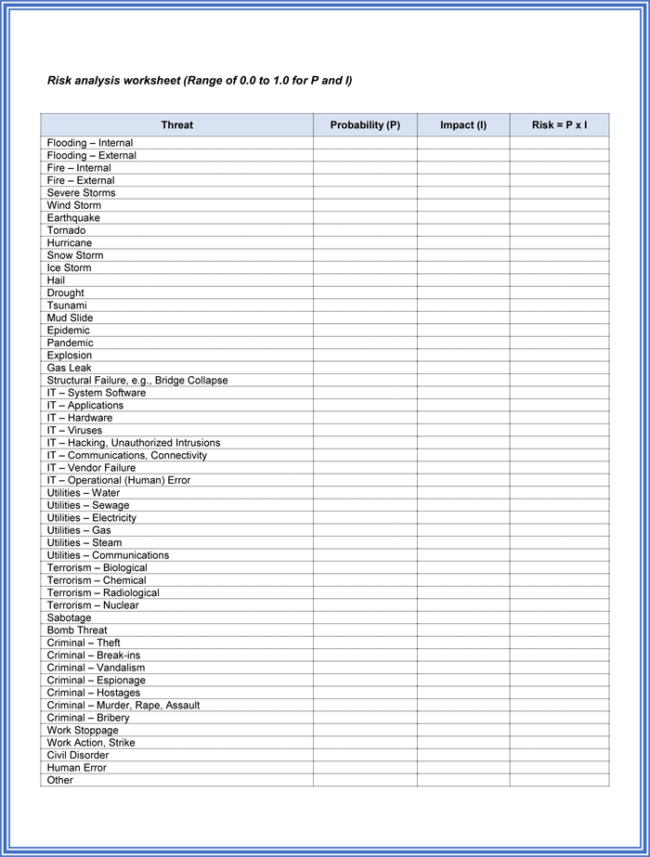10x10 Risk Matrix Creator
A project is faced with risks at every phase of its life cycle. These risks may be expected or unexpected, and when encountered, needs time and attention. Depending on the type of risk, a risk can be a boost or a hindrance to a project.In order to understand the many risks that a project faces, a in a project has to be done.
Practicality of a Risk Matrix A risk matrix can be used to: - determine whether or not a risk event needs treatment; - determine priorities for risk treatment; - link the risk rating with the level of management attention required; - determine whether an activity should be undertaken, at all.
While quantitative analysis assigns a numerical value to the risk, qualitative analysis, on the other hand, indicates the probability and the impact of the risk on the project in terms of seriousness and urgency.A project risk matrix is used when ‘qualitatively’ analyzing risks. It is a process of rating a risk’s probability against its impact.
Movie poster cheap. It is applied to individual risks and not to a group of risks in a risk sequence or to complete project as such. A sample of a project risk matrix is illustrated below. Example of a Probability Impact MatrixA probability-impact matrix is used to highlight the status of risks at a glance.
There are many ways of expressing the probability and impact relationship of risks in a project. The most popular way, however, is to rate them as Very High, High, Medium, Low, and so on.Risks with higher probability and higher impact will require more attention, and hence this risk assessment tool is most useful for.Let us assume in this sample of a project risk matrix, nine individual risks have been identified in a project (refer to the diagram). They are marked against a rating scale of High, Medium and Low for both Probability and Impact.Risk 1: Low probability and low impactRisk 2: Medium probability and low impactRisk 3: High probability and low impactRisk 4: Low probability and medium impactRisk 5: Medium probability and medium impactRisk 6: High probability and medium impactRisk 7: Low probability and high impactRisk 8: Medium probability and high impactRisk 9: High probability and high impactRisks with a low probability and low impact do not pose much of a threat to a project. They may be easily handled by the project manager/project team and might require supervision or superficial monitoring.

As the impact of the risk on a project increases, more time, attention and detailed risk management might be required, by not only the project team, but also all stakeholders involved. An identified risk with a high probability and impact may require additional funds, time and resources to overcome it.
It is indicative of urgent attention required.When a probability-rating score has been assigned to a risk as in 1-6 in the diagram, it becomes easy for all the stakeholders involved to assess the damage a risk might pose to a project, which becomes part of. The higher the P-I Score, the more aggressive the risk management approach should be.Assessment of individual risks as in the probability-impact matrix helps with.Image Credit: Diagram created by author This post is part of the series: Risk Management.

I plan to provide something like this in the next release, but it may not be what you're thinking of. What I've currently developed allows a display size up to 32x32, and each column of the display has a multibit input of up to 32 bits specifying what pixels should be lighted in that column.
(In reality, each 'pixel' is really a 10x10 square.) Alternatively, an attribute allows you to designate that instead each.row. should have a multibit input. And another provided choice is to have just two multibit inputs saying which rows and columns are 'selected' - a pixel is lighted if both its row and its column are chosen.
Risk Mapping Matrix
(The last choice sounds a bit weird, but it's an interface found in some real-life off-the-shelf components.)The display size limit of 32x32 is pretty restricted. To support more pixels, I believe there would need to be something of a video memory, which would be modified via a serial interface. There's a third-party JAR library from Cornell at that provides such a component. I'm interested in comments about whether that interface is what Logisim should provide, or other comments about how the inputs to the device should work.A completely different direction - which would also be nice - would be a TTY-like component that allows just text output. Again, I'm not sure what the interface should be.